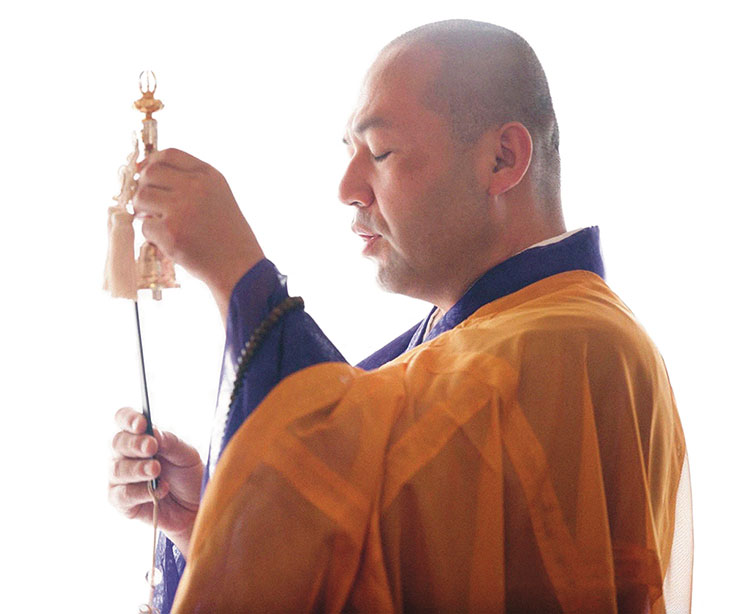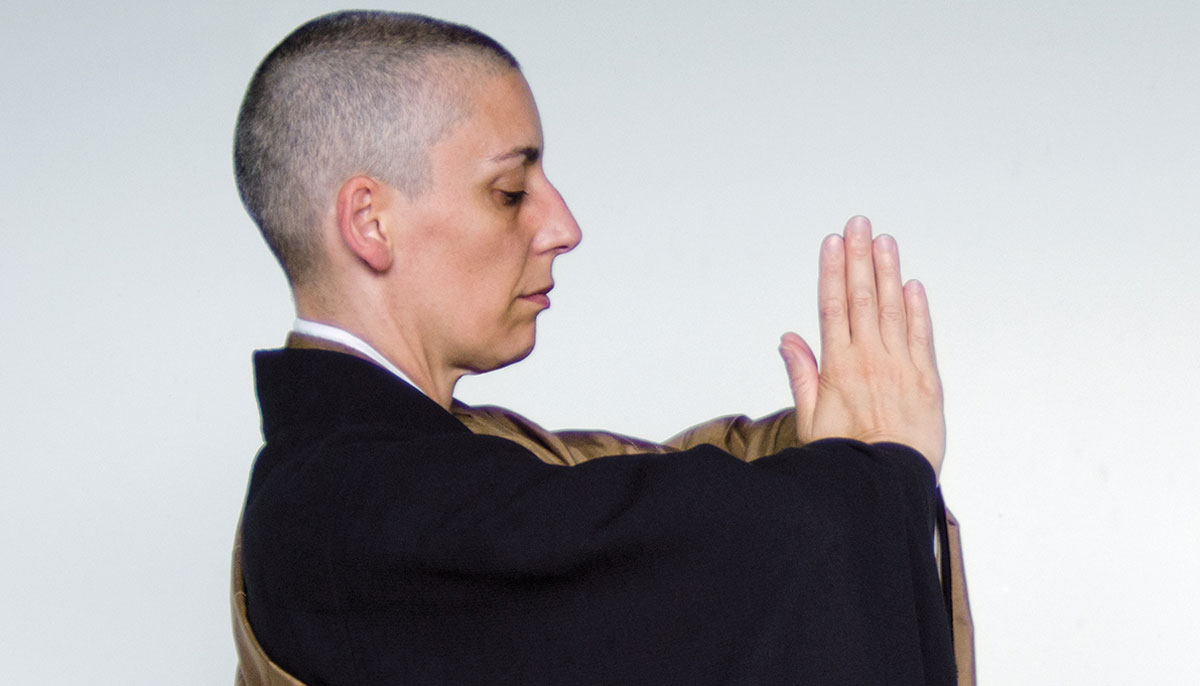One summer in the early seventies, I spent a week as a guest trainee at Tassajara Zen Mountain Center. The experience was the focal point of an extension course offered by the University of California, Santa Cruz. In the classes leading up to the main event, our instructor, Jack Weller, stressed the progressive character of Zen training. By this he hadn’t meant some romantic notion of spiritual progress into increasingly ethereal states of consciousness, but rather the way that the training moved progressively off the cushion and out into one’s activities in the world. One key element in fostering that progression from seated meditation to ordinary activities was ritual. Everything from the formal procedure for entering the meditation hall to the specific way one practices walking meditation to more elaborate rituals and ceremonies, such as the master ascending the altar to give teachings, is a part of that progressive training.
In the decades since, I’ve studied a wide variety of meditation practices, spanning from Insight to Dzogchen. Understanding that meditation is not, in fact, disconnected from either ritual or ordinary activity, but instead part of a spectrum, provided a constant and valuable frame for understanding the variety of Buddhist practices I encountered. Most important for my own practice and academic studies, it provided a way of understanding the ritual practice of Shingon, a tantric tradition of Japan. About a decade after my week at Tassajara, I entered training for the Shingon Buddhist priesthood on Mount Koya, Japan, as part of my dissertation research on the goma, the ritual votive fire offering that distinguishes that tradition.
The fact that some teachers feel the need to make efforts to validate Buddhist ritual practice is itself indicative of the dominant preconceptions that the only valid form of practice is silent seated meditation.
Before aspirants are ready to begin the formal hundred-day training program, they must first perform thousands of prostrations, placing the “five points”—knees, elbows, and forehead—on the floor, then standing up again. This is followed by two relatively simple visualization practices: “full moon visualization,” which involves looking at an image of a white circle resting on an open lotus blossom, and “‘A’ syllable visualization,” which uses an image of the syllable “A” written in Siddham, an old Sanskrit script, resting on an open lotus blossom inside a white circle. Once the aspirants are able to form a mental image of each that is strong enough to be held in mind without looking at the physical image, they are ready for the “eighteen stages” practice, named for its original form comprising eighteen paired mudras and mantras. This lays the groundwork for three core Shingon rituals: the womb mandala, the vajra mandala, and goma.
Initially, performing a three-hour-long fire offering in a temple on Mount Koya might seem far removed from the silent sitting during morning practice in the Tassajara meditation hall. In the West, ritual is frequently dismissed as “mere ritual” or described as simply doing things “by rote.” But the frame of meditation as progressive practice, continuous from silent seated practice through ritual to all activity, gave me an understanding that the complex ritual performances of tantric Buddhism are also a form of meditation. Far from being the kind of unthinking repetitious activity such characterizations imply, Shingon rituals require close attention to detail, both in preparation and performance. Performing a ritual requires that the practitioner be very present to the process. In the case of tantric ritual, that includes such actions as forming hand gestures (mudra) and reciting mantra. Like counting the breath, reciting mantra a specific number of times seems like an easy task. But just like counting the breath, doing it without losing track of what one is doing and mentally wandering away from the practice means performing a ritual action while at the same time attending both to how that action is being performed—proper pronunciation of the mantra, for example—and the number of times one has performed it—whether twenty-one times for this mantra at this point in the ritual or 108 times for the same mantra at another point.
The dichotomy between meditation and ritual is one of the very tenacious dualisms maintained in contemporary Buddhist discourse, going back to the representations of Buddhism promoted around the beginning of the twentieth century. Generally, one finds meditation uncritically treated as positive and beneficial, while ritual is either a waste of time or, even more strongly, condemned as detrimental to true practice. There have been some attempts to resuscitate ritual for contemporary Buddhism, giving it a positive value. But the fact that some teachers feel the need to make efforts to validate Buddhist ritual practice is itself indicative of the dominant preconceptions that the only valid form of practice is silent seated meditation.
This notion that because ritual is repetitive it necessarily impedes spontaneity and freedom is not unique to Western Buddhists. It is a widely shared belief in American popular religious culture. The legacy of Freud’s equation of ritual with obsessive-compulsive disorder also lingers as a negative value judgment about ritual. But the reality is quite the contrary. The process of systematic training and thorough learning of a ritual procedure allows one to be even more fully present in the moment. Like practicing jump shots in basketball or scales on the piano until they are fully present in one’s body, repetitive practice of ritual opens up the experience to an awareness of the moment in which one can be free, spontaneous, and fully present.
The History
In Western culture, the dualism that is assumed to exist between ritual and meditation, and the values placed on each of the two—meditation good, ritual bad—is a very long-standing way of thinking about the nature of religion. The clearest origin of the dichotomy stretches back to the sixteenth century, the era of the Protestant Reformation. Many of the Protestant Reformers argued for a reduction of the number of sacraments—Christian rituals—or even more radically, the complete elimination of ritual from the church. Sacraments were felt to interfere with the individual’s relation with God. More critically, as far as the Reformers were concerned, priests controlled access to the sacraments. This placed priests in the position of mediating the individual’s relationship with God, and therefore impeding direct experience of the divine.
In place of a relationship between the individual and God mediated by priests and rituals, many of the Protestant reformers promoted the goal of a direct, unmediated relationship. Prayer and reading the Bible for one’s own understanding of divine revelation came to be understood as the vehicles by which such an unmediated relationship could be established. Displacing participation in sanctioned sacraments with these individual practices, Christians were to find their own personal experience of the divine.
These ideas about ritual as empty of religious significance, and direct experience being the goal of religious practice, have taken up a seemingly permanent residence in Western religious culture. While in popular Buddhist discourse meditation has been given the positive valuation previously held by prayer, and sutra study now takes the place of Bible reading, ritual has retained the negative valuation formerly attributed to sacraments as interfering in one’s experience of the divine—now recast as “the dharma.” This can be seen in much of the discourse of contemporary Buddhism, which often promotes the superiority of some form of modernized Buddhism over other traditionally rooted forms on the grounds that this modernized Buddhism has been freed from ritual encumbrances and the superstitious beliefs that support them.
Two primary rhetorical justifications are usually offered for rejecting ritual in the promotion of modernized Buddhism. One is the recreation or renewal of Buddhism in a form that accords with the beliefs of modern people. According to this justification, what is considered to be the modern belief system—such as rationality, belief in the authority of science, a materialist view of reality, or a psychological understanding of human existence—is employed to determine what Buddhism should be.
The second is a claim that the modernized form actually represents the original teachings of the founder, Shakyamuni Buddha. This approach claims the authority of select texts from the Pali canon, often texts selected because they accord with a modern interpreter’s own preexisting views. Even in instances where there is careful scholarship employed to identify the earliest strata of textual sources, there arises a second problem of interpretation. Texts do not exist in some realm of timeless truth. They are always located, both in their creation and in their contemporary interpretation. Treating a text as if it can simply be abstracted out of its social and cultural context is, in fact, to strip it of its full original meaning; treating it as if we can simply locate it in relation to our own contemporary concerns imposes our own meanings onto it. While fundamentalists—whether Biblical or Buddhist—assert that a naive, uninformed reading of a religious text is the best means of revealing its meaning, such a reading only unreflectively locates our own meanings into the text.

The Thought-Action Dichotomy
The distinction between meditation and ritual also plays on the distinction between internal and experiential contrasted with external and physical, what has been called the thought–action dichotomy. In Western society, the dichotomy between thought and action gives primacy to thought over action, making thought determinative of action. The celebration of self-directed choice as responsible action, and the emphasis in much of popular Buddhism on using meditation to improve self-control, illustrate this conception of the primacy of the mental.
Jonathan Z. Smith, noted scholar of religious studies, has pointed out the ways in which pairs of opposites used to describe religion come to be matched with one another. For the relationship between meditation and ritual, the most relevant is the pairing of spiritual with internal, which is then set in opposition to the pairing of material and external. In turn, spiritual/internal comes to be paired with experiential and meditative, while material/external is paired with meaningless rote action and empty ritual. Such oppositional pairings of concepts have a great deal of power in directing how we think about practice.
Dissolving the Dichotomy
Calling attention to the power of oppositional pairings points to the further goal of this reflection. There is no point in simply reversing the valuation of meditation as positive and ritual as negative; from a nondual perspective, it is the dichotomy itself that creates problems. In place of the opposition of meditation as internal and ritual as external, we need to recognize that action entails thought and thought involves action. In other words, all meditation involves some degree of ritualization, from something as simple as making a regular time for meditating, sitting in a particular posture, and engaging in a short breathing exercise to start, up to increasingly ritualized activities such as lighting incense, sounding a bell, and chanting before and after the meditation. Likewise, all ritual involves some degree of meditation, from simply attending closely to the actions required to engaging in complex visualizations of the Buddha, bodhisattvas, and guardian deities.
The predominant view of ritual and meditation as mutually exclusive opposites is not grounded in simple reality; rather, it is an historical construction that grew out of a specific time and place and in service to a particular religious worldview. Our contemporary interpretation of that worldview has led us to extol meditation while denigrating ritual. If we are to become fully rounded practitioners, we must overcome this dualistic approach and learn to see the two as complementary, amplifying and supporting one another. External forms provide structure and consistency to boundless internal experience. From this perspective, every practice is located somewhere on the spectrum of ritualized action, while at the same time an opportunity to experience absolute reality, unbound by form.


